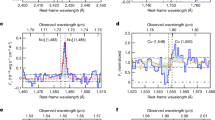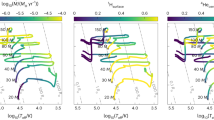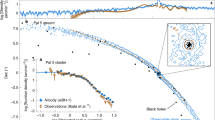Abstract
The appearance of supermassive black holes at very early times1–3 in the Universe is a challenge to our understanding of star and black hole formation. The direct-collapse4,5 black hole scenario provides a potential solution. A prerequisite for forming a direct-collapse black hole is that the formation of (much less massive) population III stars be avoided6,7; this can be achieved by destroying H2 by means of Lyman–Werner radiation (photons of energy around 12.6 eV). Here we show that two conditions must be met in the protogalaxy that will host the direct-collapse black hole. First, prior star formation must be delayed; this can be achieved with a background Lyman–Werner flux of JBG ≳ 100J21 (J21 is the intensity of background radiation in units of 10−21 erg cm−2 s−1 Hz−1 sr−1). Second, an intense burst of Lyman–Werner radiation from a neighbouring star-bursting protogalaxy is required, just before the gas cloud undergoes gravitational collapse, to suppress star formation completely. Using high-resolution hydrodynamical simulations that include full radiative transfer, we find that these two conditions inevitably move the host protogalaxy onto the isothermal atomic cooling track, without the deleterious effects of either photo-evaporating the gas or polluting it with heavy elements. These atomically cooled, massive protogalaxies are expected ultimately to form a direct-collapse black hole of mass 104−105M⊙.
This is a preview of subscription content, access via your institution
Access options
Access Nature and 54 other Nature Portfolio journals
Get Nature+, our best-value online-access subscription
$29.99 / 30 days
cancel any time
Subscribe to this journal
Receive 12 digital issues and online access to articles
$119.00 per year
only $9.92 per issue
Buy this article
- Purchase on Springer Link
- Instant access to full article PDF
Prices may be subject to local taxes which are calculated during checkout




Similar content being viewed by others
References
Fan, X., Carilli, C. L. & Keating, B. Observational constraints on cosmic reionization. Annu. Rev. Astron. Astrophys. 44, 415–462 (2006).
Mortlock, D. J. et al. A luminous quasar at a redshift of z = 7.085. Nature 474, 616–619 (2011).
Wu, X.-B. et al. An ultraluminous quasar with a twelve-billion-solar-mass black hole at redshift 6.30. Nature 518, 512–515 (2015).
Loeb, A. & Rasio, F. A. Collapse of primordial gas clouds and the formation of quasar black holes. Astrophys. J. 432, 52–61 (1994).
Begelman, M. C., Volonteri, M. & Rees, M. J. Formation of supermassive black holes by direct collapse in pre-galactic haloes. Mon. Not. R. Astron. Soc. 370, 289–298 (2006).
Omukai, K. Primordial star formation under far-ultraviolet radiation. Astrophys. J. 546, 635–651 (2001).
Oh, S. P. & Haiman, Z. Second-generation objects in the universe: radiative cooling and collapse of halos with virial temperatures above 104 K. Astrophys. J. 569, 558–572 (2002).
Bryan, G. L. et al. Enzo: an adaptive mesh refinement code for astrophysics. Astrophys. J. Suppl. 211, 19 (2014).
Smith, B. D. et al. Grackle: a chemistry and cooling library for astrophysics. Preprint at https://arxiv.org/abs/1610.09591 (2016).
Wise, J. H. & Abel, T. Enzo+Moray: radiation hydrodynamics adaptive mesh refinement simulations with adaptive ray tracing. Mon. Not. R. Astron. Soc. 414, 3458–3491 (2011).
Dijkstra, M., Haiman, Z., Mesinger, A. & Wyithe, J. S. B. Fluctuations in the high-redshift Lyman–Werner background: close halo pairs as the origin of supermassive black holes. Mon. Not. R. Astron. Soc. 391, 1961–1972 (2008).
Yue, B., Ferrara, A., Salvaterra, R., Xu, Y. & Chen, X. The brief era of direct collapse black hole formation. Mon. Not. R. Astron. Soc. 440, 1263–1273 (2014).
Agarwal, B., Davis, A. J., Khochfar, S., Natarajan, P. & Dunlop, J. S. Unravelling obese black holes in the first galaxies. Mon. Not. R. Astron. Soc. 432, 3438–3444 (2013).
Agarwal, B., Dalla Vecchia, C., Johnson, J. L., Khochfar, S. & Paardekooper, J.-P. The First Billion Years project: birthplaces of direct collapse black holes. Mon. Not. R. Astron. Soc. 443, 648–657 (2014).
Visbal, E., Haiman, Z. & Bryan, G. L. Direct collapse black hole formation from synchronized pairs of atomic cooling haloes. Mon. Not. R. Astron. Soc. 445, 1056–1063 (2014).
Smith, B. D., Wise, J. H., O’Shea, B. W., Norman, M. L. & Khochfar, S. The first Population II stars formed in externally enriched mini-haloes. Mon. Not. R. Astron. Soc. 452, 2822–2836 (2015).
Regan, J. A., Johansson, P. H. & Wise, J. H. Forming super-massive black hole seeds under the influence of a nearby anisotropic multi-frequency source. Mon. Not. R. Astron. Soc. 459, 3377–3394 (2016).
Xu, H., Wise, J. H. & Norman, M. L. Population III stars and remnants in high-redshift galaxies. Astrophys. J. 773, 83 (2013).
Chon, S., Hirano, S., Hosokawa, T. & Yoshida, N. Cosmological simulations of early black hole formation: halo mergers, tidal disruption, and the conditions for direct collapse. Astrophys. J. 832, 134 (2016).
Ahn, K., Shapiro, P. R., Iliev, I. T., Mellema, G. & Pen, U.-L. The inhomogeneous background of H2-dissociating radiation during cosmic reionization. Astrophys. J. 695, 1430–1445 (2009).
Dijkstra, M., Ferrara, A. & Mesinger, A. Feedback-regulated supermassive black hole seed formation. Mon. Not. R. Astron. Soc. 442, 2036–2047 (2014).
Pacucci, F., Ferrara, A., Volonteri, M. & Dubus, G. Shining in the dark: the spectral evolution of the first black holes. Mon. Not. R. Astron. Soc. 454, 3771–3777 (2015).
Natarajan, P. et al. Unveiling the first black holes with JWST: multi-wavelength spectral predictions. Preprint at http://arxiv.org/abs/1610.05312 (2016).
Glover, S. C. O. Simulating the formation of massive seed black holes in the early Universe. I: An improved chemical model. Mon. Not. R. Astron. Soc. 451, 2082–2096 (2015).
Glover, S. C. O. Simulating the formation of massive seed black holes in the early Universe. II: Impact of rate coefficient uncertainties. Mon. Not. R. Astron. Soc. 453, 2901–2918 (2015).
Regan, J. A., Johansson, P. H. & Wise, J. H. The effect of dark matter resolution on the collapse of baryons in high-redshift numerical simulations. Mon. Not. R. Astron. Soc. 449, 3766–3779 (2015).
Hahn, O. & Abel, T. Multi-scale initial conditions for cosmological simulations. Mon. Not. R. Astron. Soc. 415, 2101–2121 (2011).
Kitsionas, S. & Whitworth, A. P. Smoothed particle hydrodynamics with particle splitting, applied to self-gravitating collapse. Mon. Not. R. Astron. Soc. 330, 129–136 (2002).
Shang, C., Bryan, G. L. & Haiman, Z. Supermassive black hole formation by direct collapse: keeping protogalactic gas H2 free in dark matter haloes with virial temperatures Tvir ≳104 K. Mon. Not. R. Astron. Soc. 402, 1249–1262 (2010).
Latif, M. A. et al. A UV flux constraint on the formation of direct collapse black holes. Mon. Not. R. Astron. Soc. 443, 1979–1987 (2014).
Latif, M. A., Schleicher, D. R. G., Bovino, S., Grassi, T. & Spaans, M. The formation of massive primordial stars in the presence of moderate UV backgrounds. Astrophys. J. 792, 78 (2014).
Agarwal, B. & Khochfar, S. Revised rate coefficients for H2 and H− destruction by realistic stellar spectra. Mon. Not. R. Astron. Soc. 446, 160–168 (2015).
Wolcott-Green, J. & Haiman, Z. Feedback from the infrared background in the early Universe. Mon. Not. R. Astron. Soc. 425, L51–L55 (2012).
Wolcott-Green, J., Haiman, Z. & Bryan, G. L. Beyond Jcrit: a critical curve for suppression of H2-cooling in protogalaxies. Preprint at http://arxiv.org/abs/1609.02142 (2016).
Machacek, M. E., Bryan, G. L. & Abel, T. Simulations of pregalactic structure formation with radiative feedback. Astrophys. J. 548, 509–521 (2001).
O’Shea, B. W. & Norman, M. L. Population III star formation in a ΛCDM universe. II: Effects of a photodissociating background. Astrophys. J. 673, 14–33 (2008).
Abel, T. & Wandelt, B. D. Adaptive ray tracing for radiative transfer around point sources. Mon. Not. R. Astron. Soc. 330, L53–L56 (2002).
Górski, K. M. et al. HEALPix: a framework for high-resolution discretization and fast analysis of data distributed on the sphere. Astrophys. J. 622, 759–771 (2005).
Wolcott-Green, J., Haiman, Z. & Bryan, G. L. Photodissociation of H2 in protogalaxies: modelling self-shielding in three-dimensional simulations. Mon. Not. R. Astron. Soc. 418, 838–852 (2011).
Chen, P., Wise, J. H., Norman, M. L., Xu, H. & O’Shea, B. W. Scaling relations for galaxies prior to reionization. Astrophys. J. 795, 144 (2014).
Bruzual, G. & Charlot, S. Stellar population synthesis at the resolution of 2003. Mon. Not. R. Astron. Soc. 344, 1000–1028 (2003).
Schaerer, D. On the properties of massive Population III stars and metal-free stellar populations. Astron. Astrophys. 382, 28–42 (2002).
Gunn, J. E. & Gott, J. R. III . On the infall of matter into clusters of galaxies and some effects on their evolution. Astrophys. J. 176, 1–19 (1972).
Gisler, G. R. The fate of gas in elliptical galaxies and the density evolution of radio sources. Astron. Astrophys. 51, 137–150 (1976).
McCarthy, I. G. et al. Ram pressure stripping the hot gaseous haloes of galaxies in groups and clusters. Mon. Not. R. Astron. Soc. 383, 593–605 (2008).
Hosokawa, T., Omukai, K. & Yorke, H. W. Rapidly accreting supergiant protostars: embryos of supermassive black holes? Astrophys. J. 756, 93 (2012).
Hosokawa, T., Yorke, H. W., Inayoshi, K., Omukai, K. & Yoshida, N. Formation of primordial supermassive stars by rapid mass accretion. Astrophys. J. 778, 178 (2013).
Schleicher, D. R. G., Palla, F., Ferrara, A., Galli, D. & Latif, M. Massive black hole factories: Supermassive and quasi-star formation in primordial halos. Astron. Astrophys. 558, A59 (2013).
Fiacconi, D. & Rossi, E. M. Bright vigorous winds as signposts of supermassive black hole birth. Mon. Not. R. Astron. Soc. 455, 2–16 (2016).
Nakauchi, D., Hosokawa, T., Omukai, K., Saio, H. & Nomoto, K. Do stellar winds prevent the formation of supermassive stars by accretion? Mon. Not. R. Astron. Soc. 465, 5016–5025 (2017).
Regan, J. A., Johansson, P. H. & Haehnelt, M. G. Numerical resolution effects on simulations of massive black hole seeds. Mon. Not. R. Astron. Soc. 439, 1160–1175 (2014).
Inayoshi, K. & Haiman, Z. Does disc fragmentation prevent the formation of supermassive stars in protogalaxies? Mon. Not. R. Astron. Soc. 445, 1549–1557 (2014).
Regan, J. A. & Haehnelt, M. G. Pathways to massive black holes and compact star clusters in pre-galactic dark matter haloes with virial temperatures 10000 K. Mon. Not. R. Astron. Soc. 396, 343–353 (2009).
Fialkov, A., Barkana, R., Visbal, E., Tseliakhovich, D. & Hirata, C. M. The 21-cm signature of the first stars during the Lyman–Werner feedback era. Mon. Not. R. Astron. Soc. 432, 2909–2916 (2013).
Visbal, E., Haiman, Z., Terrazas, B., Bryan, G. L. & Barkana, R. High-redshift star formation in a time-dependent Lyman–Werner background. Mon. Not. R. Astron. Soc. 445, 107–114 (2014).
Visbal, E., Haiman, Z. & Bryan, G. L. Limits on Population III star formation in minihaloes implied by Planck. Mon. Not. R. Astron. Soc. 453, 4456–4466 (2015).
Tseliakhovich, D. & Hirata, C. Relative velocity of dark matter and baryonic fluids and the formation of the first structures. Phys. Rev. D 82, 083520 (2010).
Stacy, A., Bromm, V. & Loeb, A. Effect of streaming motion of baryons relative to dark matter on the formation of the first stars. Astrophys. J. Lett. 730, L1 (2011).
Fialkov, A., Barkana, R., Tseliakhovich, D. & Hirata, C. M. Impact of the relative motion between the dark matter and baryons on the first stars: semi-analytical modelling. Mon. Not. R. Astron. Soc. 424, 1335–1345 (2012).
Naoz, S., Yoshida, N. & Gnedin, N. Y. Simulations of early baryonic structure formation with stream velocity. II: The gas fraction. Astrophys. J. 763, 27 (2013).
Tanaka, T. L. & Li, M. The formation of massive black holes in z ∼ 30 dark matter haloes with large baryonic streaming velocities. Mon. Not. R. Astron. Soc. 439, 1092–1100 (2014).
Fernandez, R., Bryan, G. L., Haiman, Z. & Li, M. H2 suppression with shocking inflows: testing a pathway for supermassive black hole formation. Mon. Not. R. Astron. Soc. 439, 3798–3807 (2014).
Visbal, E., Haiman, Z. & Bryan, G. L. A no-go theorem for direct collapse black holes without a strong ultraviolet background. Mon. Not. R. Astron. Soc. 442, L100–L104 (2014).
Acknowledgements
This work was supported by the Science and Technology Facilities Council (grant numbers ST/L00075X/1 and RF040365) and by NASA grant NNX15AB19G (to Z.H.). J.R. acknowledges support from the EU Commission via the Marie Skłodowska-Curie Grant SMARTSTARS, grant number 699941. J.W. is supported by National Science Foundation grants AST-1333360 and AST-1614333, and by Hubble theory grants HST-AR-13895 and HST-AR-14326. P.H.J. acknowledges the support of the Academy of Finland grant 1274931. G.B. acknowledges financial support from NASA grant NNX15AB20G and NSF grant AST-1312888. This work used the DiRAC Data Centric system at Durham University, operated by the Institute for Computational Cosmology on behalf of the STFC DiRAC HPC Facility (www.dirac.ac.uk). This equipment was funded by BIS National E-infrastructure capital grant ST/K00042X/1, STFC capital grant ST/H008519/1 and STFC DiRAC Operations grant ST/K003267/1, and by Durham University. DiRAC is part of the National E-Infrastructure. Some of the preliminary numerical simulations were also performed on facilities hosted by the CSC-IT Center for Science in Espoo, Finland, which are financed by the Finnish ministry of education. The Flatiron Institute is supported by the Simons Foundation. Z.H. acknowledges support from a Simons Fellowship for Theoretical Physics. The freely available astrophysical analysis code yt and plotting library matplotlib were used to construct numerous plots within this paper. Computations described in this work were performed using the publicly available Enzo code, which is the product of a collaborative effort of many independent scientists from institutions around the world.
Author information
Authors and Affiliations
Contributions
J.A.R. modified the publicly available Enzo code and Grackle codes used in this work, ran and analysed the code results, and wrote the initial manuscript. J.A.R., Z.H., J.H.W. and E.V. determined the simulation set-up. The radiation particle model was conceived and designed by J.A.R., P.H.J. and J.H.W. All authors contributed to the interpretation of the results and to the text of the final manuscript.
Corresponding author
Ethics declarations
Competing interests
The authors declare no competing financial interests.
Supplementary information
Supplementary Information
Supplementary Figure 1 and Supplementary Tables 1–2. (PDF 150 kb)
Rights and permissions
About this article
Cite this article
Regan, J., Visbal, E., Wise, J. et al. Rapid formation of massive black holes in close proximity to embryonic protogalaxies. Nat Astron 1, 0075 (2017). https://doi.org/10.1038/s41550-017-0075
Received:
Accepted:
Published:
DOI: https://doi.org/10.1038/s41550-017-0075
This article is cited by
-
Astrophysics with the Laser Interferometer Space Antenna
Living Reviews in Relativity (2023)
-
Formation of the First Stars and Black Holes
Space Science Reviews (2020)
-
Observational signatures of massive black hole formation in the early Universe
Nature Astronomy (2018)
-
Black Holes: The making of a monster
Nature Astronomy (2017)



